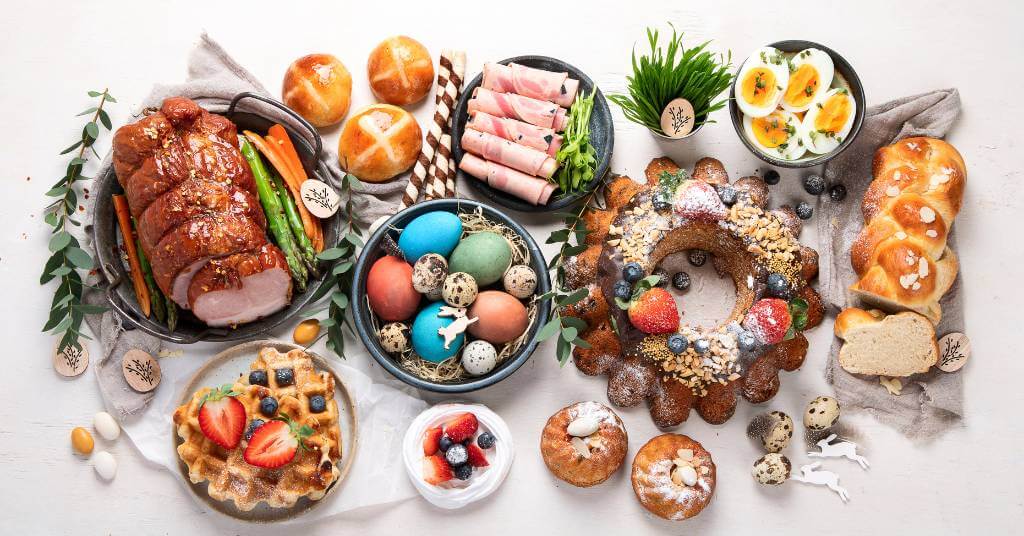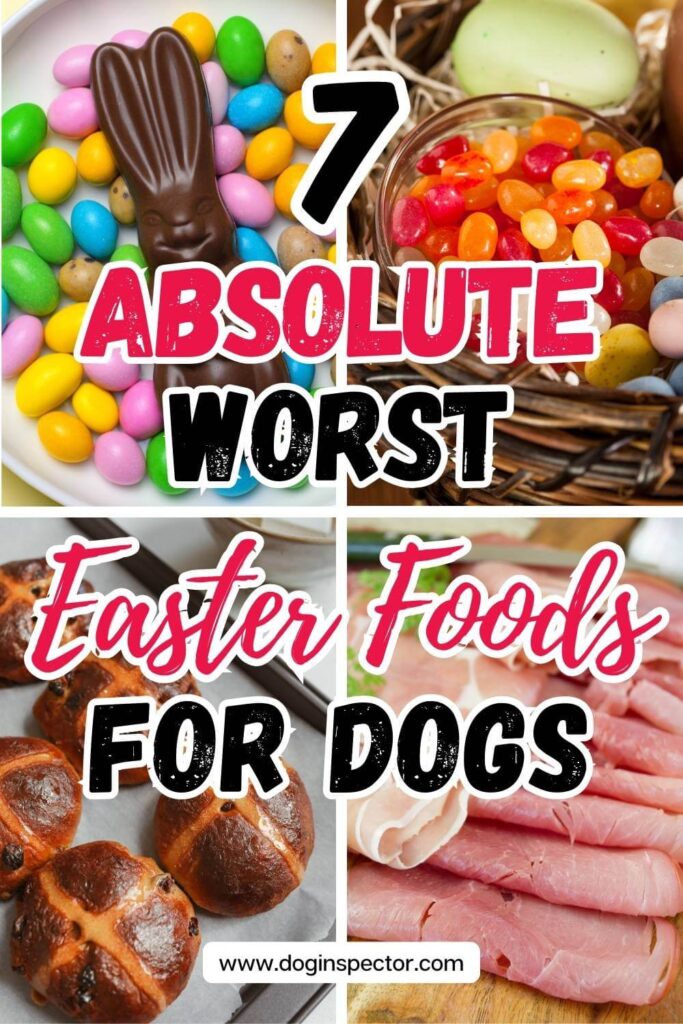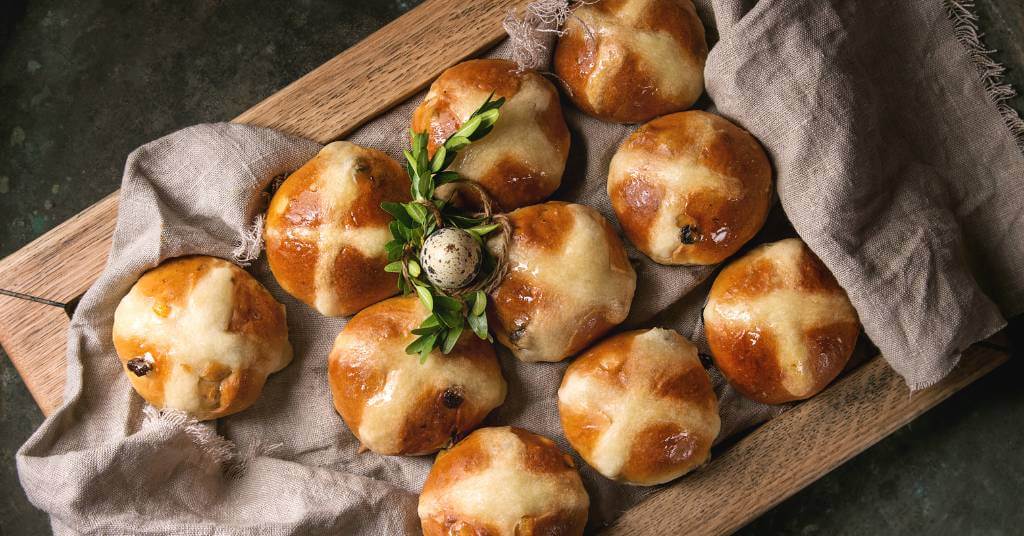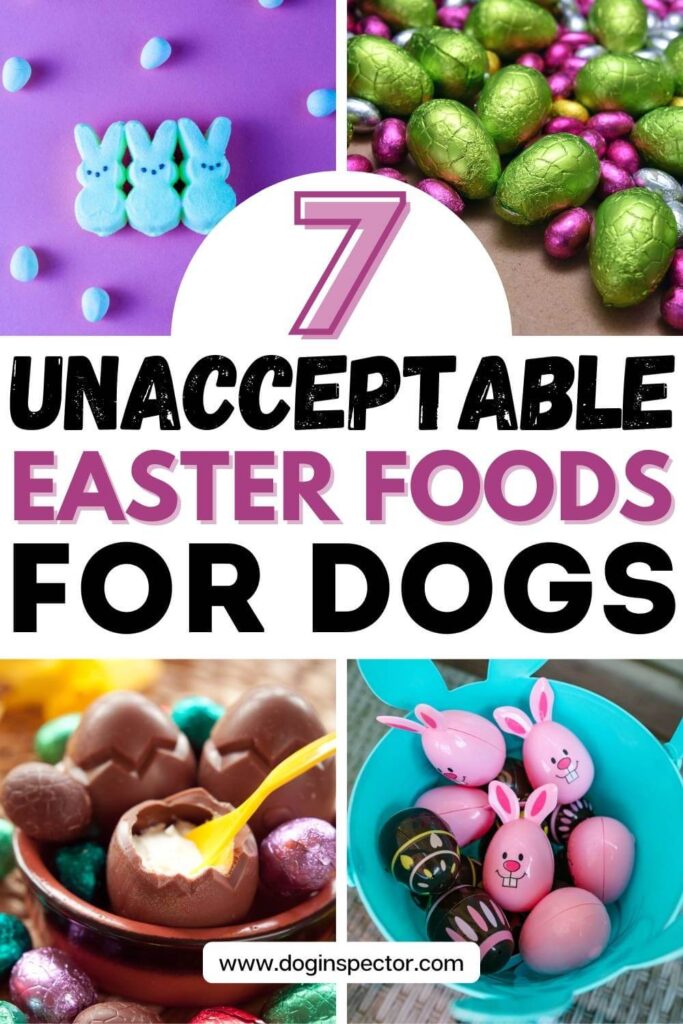7 Easter Foods Dogs Should Never Eat (and What to Do If They Do)
This post shows you the 7 Easter Foods Dogs Should Never Eat (and What to Do If They Do). My goal is to help you get through Easter without visiting the vet and enjoy the holiday with your dog!

Don’t worry; most Easter foods are not dangerous, and even that sneaky piece of chocolate they ate won’t cause immediate harm! Still, it’s better to know how to prepare, so keep on reading!

1 Chocolate
Chocolate is probably the most dangerous Easter treat your dog could get his paws on. It’s toxic to dogs because it contains theobromine, a substance similar to caffeine that dogs can’t process the same way we can.
Sometimes, even small amounts of chocolate can be toxic to dogs. However, not all types of chocolate are equally harmful, and not all dogs will react the same way.
If you’re really interested in this, a while ago, I took a deep dive and analyzed several studies about dogs and chocolate, so you can check it out. But to sum it up, dark chocolate is the most dangerous type for dogs because it has a lot of cocoa and, therefore, the most theobromine.
Other types of chocolate, like milk chocolate and typical Easter chocolate bunnies and eggs, are not as dangerous, especially for larger dogs.
So, you shouldn’t give your dog any chocolate, but if they eat some, don’t panic.
You need to watch out for symptoms like panting, a fast heartbeat, vomiting, and diarrhea.
If your dog ate a small piece, nothing will happen. But if they ate a whole box of chocolate or an entire Easter Bunny, then you really need to call your vet or the ASPCA Animal Poison Control Center for guidance.
- Pet Poison Helpline, 855-764-7661, http://www.petpoisonhelpline.com
- ASPCA Animal Poison Control Center, 888-426-4435, www.aspca.org/pet-care/animal-poison-control
As I said, chocolate is dangerous for dogs, but most of the time, dogs end up just fine because they don’t eat too much.
2 Artificial Sweeteners (Xylitol in Easter Candy)

Now, sugar-free candy is actually more dangerous than chocolate, but the only reason I put it at number two is that you’re more likely to buy real Easter chocolate than sugar-free stuff.
But still, you need to be careful.
Sugar-free candy and sweets are only really dangerous if they contain xylitol, a sugar substitute that’s actually pretty good and safe for us (it’s a natural sweetener) but extremely toxic to dogs.
It causes a rapid drop in blood sugar and potential liver failure, so you really need to watch out.
If you’re eating a low-carb, zero-carb, or low-calorie diet this Easter, be extra cautious with sweets like sugar-free marshmallows, sour candy, sugar-free pudding, or frozen yogurt.
If you know you’ll have these foods around this Easter, make sure your dog can’t get to them.
The problem is that xylitol acts fast—signs of poisoning can appear within 30 minutes.
3 Raisins in Hot Cross Buns

It wouldn’t be Easter without Hot Cross Buns!
Similar to Christmas Fruit Cake, Hot Cross Buns contain raisins, which is what makes them dangerous for dogs.
Hot Cross Buns are sweet rolls made with raisins or currants and marked with a cross on top. They taste absolutely divine, and if you’re someone who likes Panettone or Christmas Fruit Cake, then you’ll absolutely love Hot Cross Buns (if you don’t love them already!).
Raisins (just like grapes) are very dangerous to dogs and are considered toxic. They can cause kidney failure, and it’s not really clear how much is enough to be dangerous.
The scariest part? Some dogs get sick from just a couple of raisins, while others can eat more without immediate symptoms. Sometimes, there are no signs at all at first, so the best approach is to never share these fruit cakes with dogs and keep all treats with raisins away from them (this includes granola, energy bars, and some types of cookies).
4 Easter Bread (Yeast Can Be Dangerous)
If you’re making Easter bread, then first—hats off to you because there’s nothing better than homemade bread!
But if your dog acts like a kitchen elf, always sneaking around, make sure you’re being careful, as raw dough is very dangerous for dogs.
Now, you may ask yourself—but who on earth gives their dog raw dough? Well, probably no one, but you wouldn’t believe the things dogs manage to eat. From raw dough to licking flour off the table—even tearing into bags of flour… things can happen.
The problem with raw yeast dough is that it keeps rising in their stomach! This can cause severe bloating and even something like alcohol poisoning since the yeast continues to ferment inside their stomach.
I know it sounds silly, but it’s best to be careful. And if your dog loves bread that much (mine loves egg buns!), then it’s okay to give them a tiny piece so they don’t feel left out. But remember, bread isn’t real dog food (it doesn’t have the nourishing nutrients), and it’s not something you should give them too often.
5 Fatty Meats
Whether you’re making a traditional Easter glazed ham, roast chicken, or even lamb chops, please don’t give too much fatty meat to your dog!
At first, they’ll love it—of course they will. But fatty meats are horrible for them and almost always lead to diarrhea.
While diarrhea from eating too much fatty meat is usually temporary, the bigger concern is the long-term effects of too much fat. It can contribute to pancreatitis, a condition that can be really dangerous for dogs. That’s why fatty meats are among the Easter foods dogs should never eat, especially in large amounts.
Now, one holiday slip-up won’t cause harm, but you should still be careful with fatty meats, creamy sauces, and gravy since they can upset your dog’s stomach and, over time, lead to serious health problems.
6 Marshmallow Peeps (Sugar Overload and Sometimes Xylitol)

We buy and eat way too much candy for Easter, but luckily, most of it isn’t toxic to dogs.
Only sugar-free Easter candy that contains xylitol is truly dangerous for dogs. Everything else isn’t healthy, but at least it’s not toxic—even if it has other sugar substitutes.
But be careful with Easter candy like Marshmallow Peeps and other sugary treats. While they’re not toxic, too much sugar and corn syrup can cause stomach issues, vomiting, and diarrhea, and it can spike blood sugar.
You especially need to be careful with puppies and senior dogs.
7 Candy Wrappers and Plastic Grass (Choking Hazard)
Candy wrappers, plastic Easter eggs, and that fake plastic grass in baskets can be just as tempting to dogs. Dogs love to chew on things they shouldn’t, and it’s not unusual for them to swallow a candy wrapper or try to eat plastic grass. Foil wrappers can also have leftover chocolate inside, making them extra risky.
If your dog eats something like plastic grass or a wrapper, it might not pass through their system easily. It can cause an intestinal blockage, which leads to vomiting, loss of appetite, and serious discomfort. In some cases, surgery is needed.
Whatever you do, don’t try to induce vomiting, as it’s better to let it out the other way.
If you notice anything off, call your vet. But if they ate a large piece or seem distressed, don’t wait—get them checked out.
Now, you’re all prepared to have a happy Easter with your dog! Enjoy!
Don’t forget to pin this post so you’ll always have these safety tips handy!
Love, life, and fur forever!

This post showed you the 7 Easter Foods Dogs Should Never Eat (and What to Do If They Do).
You may also like: